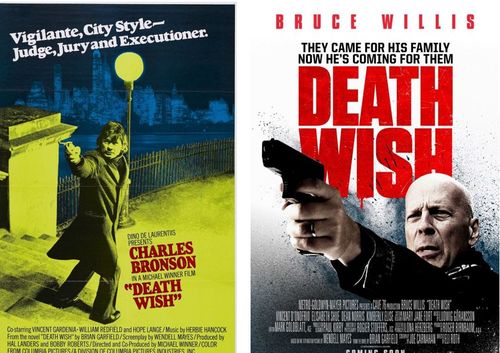VDARE.com writer Paul Kersey has, purely by coincidence I assure you (for legal reasons) the same name as the Charles Bronson character in the movie Death Wish, and now the Bruce Willis character in the remake. We'll run a Kersey review of the remake tonight, but I just thought I'd remind you what Hollywood did to the original Brian Garfield novel, which I read at the time, as well as seeing the first movie.
In the book Death Wish, a bleeding-heart liberal in 1970s New York is radicalized by brutal home invasion which happens while he's out, which leaves the wife dead, and the daughter institutionalized. His response is to go on the streets, looking vulnerable but carrying a gun, and killing the random muggers who choose to attack him.
![Hollywoods DEATH WISH Hollywoods DEATH WISH]()
This was made into the iconic Charles Bronson movie, two years later.
A 1950s novel about Hollywood described the adaptation of a book into a movie like this.
"Say they buy a book. Here's about how it goes, with a few of my slight exaggerations. First thing, you got to change the title. That's imperative. Then the studio gets about seven hundred writers to work on the book, make adaptations, put together a screen play. You take out some of the characters and put in others, see? If there's any sex in it you take it out [for the pre-1968 Production Code]and put in Love—or a pie in the face. You take out everything else and put other things in the script in place of it. Then you change the title again. The idea is to make the book completely unrecognizable. This is very important, because otherwise the film wouldn't stink."
Well, they almost changed the name to "The Sidewalk Vigilante", and they changed New York liberal Jewish accountant Paul Benjamin to New York liberal non-Jewish architect Paul Kersey, but the real change was the in the race of the violent criminals who brutalize Mrs. Kersey and their daughter.
This is from the book by Brian Garfield:
Detective: "She did give us something of a description, though.”
Paul Benjamin: “Oh?”
Detective: “She seemed to be pretty sure that two of them were Puerto Ricans and the third was black. Of course he may have been a black Puerto Rican—there are quite a few of them.”
Paul Benjamin: “Well, isn’t there a method you people use of reconstructing faces with drawings of various features?”
Detective: “The Identikit, yes, sir. She didn’t seem to feel up to that.”
Paul Benjamin: “Well, she should be feeling better within a few days.”
In fact, the daughter never recovers. Women frequently don’t. One of Caryl Chessman’s victims was confined to a mental institution as a result of his rape of her.
However, in the brutal attack scene, in which Hope Lange plays the mother, the two woman are brutalized not by two Puerto Ricans and a black, but by, going by the actors' races, an Irish-American,a a Greek-American, and, in his first-ever appearance on film—Jeff Goldblum.
![]()
That was not, and is not, the face of street crime in New York, but it's the face Hollywood wants to show us.















